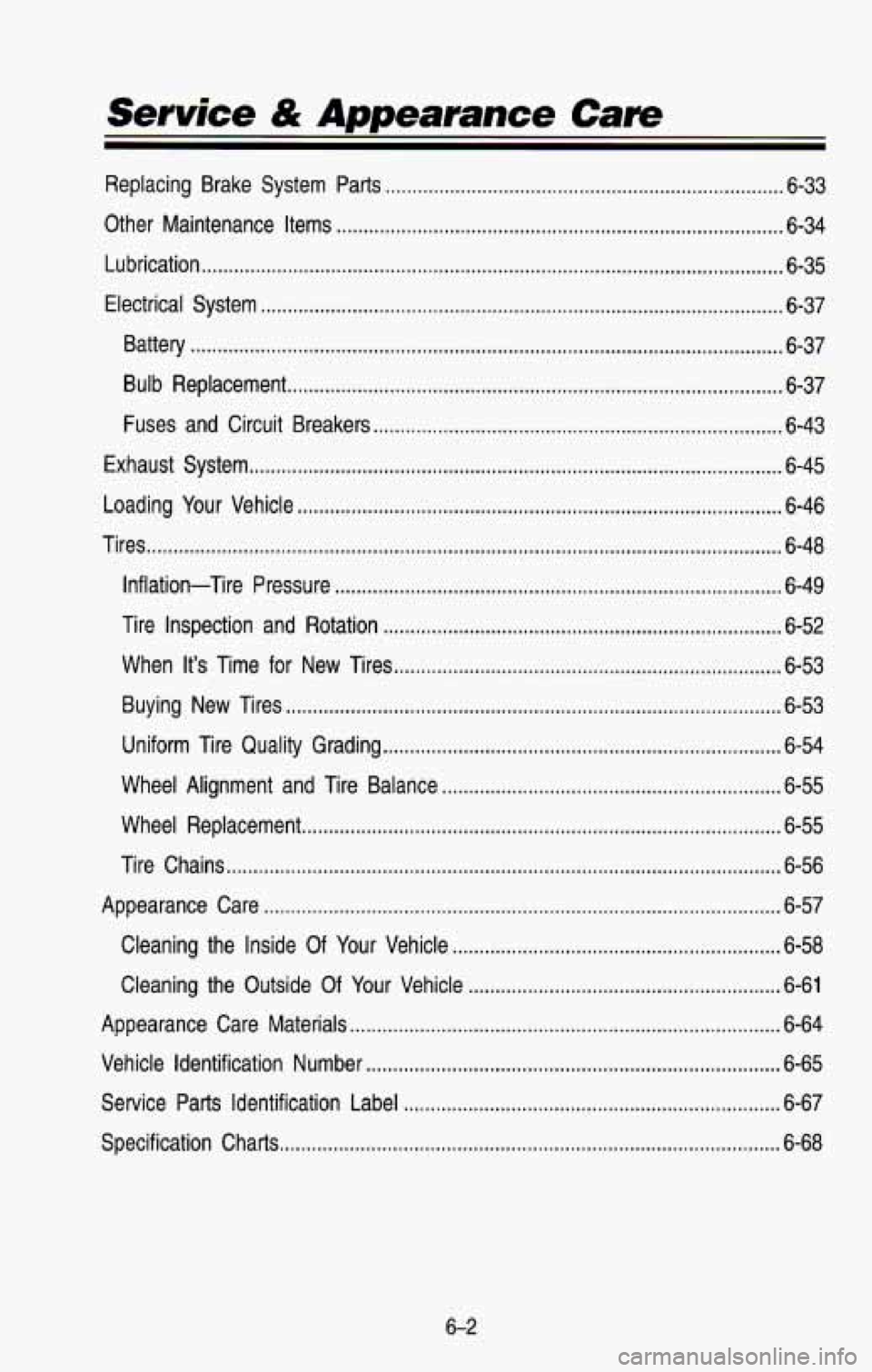1993 CHEVROLET BLAZER maintenance
[x] Cancel search: maintenancePage 2 of 386

INTRODUCTION
I993 Blazer and Suburban
Owner’s Manual
Welcome
This manual was prepared to acquaint you with the operation an\
d maintenance
of your 1993 Chevrolet truck, and to provide important safety
information. There is also a Chevrolet Truck Warranty and Owner Assistance
Information booklet. In some vehicles, there can be information manuals from
other manufacturers like body builders or special equipment comp\
anies. We
urge you to review all these publications carefully. This will help you enjoy
safe and trouble-free operation
of your vehicle.
When
it comes to service, keep in mind that your Chevrolet dealer knows
your vehicle best and is interested in your complete satisfaction. Your dealer
invites you to return for
all of your service needs both during and after the
warranty period.
Remember, if you have a concern and need help handling
it to your
satisfaction see the procedure in Section
8, or in the Chevrolet Truck
Warranty and Owner Assistance Information booklet.
Thanks for choosing a Chevrolet product. We value you as a member of the
Chevrolet family. We want to assure you
of our continuing interest in your
pleasure and satisfaction with your vehicle.
Chevrolet Motor Division
General Motors Corporation
30007 Van Dyke Ave.
Warren, Michigan
48090
@Copyright 7992 General Motors Corporation, Chevrolet Motor Division.
All Rights Reserved
aecond Edition
i
Printed in USA
Page 6 of 386

Section
0
This section tells you how to use your manual and includes
safety and vehicle damage warnings and symbols.
L
A
This section tells you how to use your seats and safety belts
properly.
1 This section explains how to start and operate your vehicle.
3
This section tells you how to adjust the ventilation and comfort
controls and how to operate your audio system.
Here
YOU II find helpful information and tips about the road and
how to drive under different conditions.
5
This section tells you what to do if you have a problem while
driving, such as
a flat tire or engine overheating.
Here the manual tells you how to keep your vehicle running
properly and looking
good.
This section tells you when to perform vehicle maintenance and
what fluids and lubricants to use.
This section tells you how
to contact your GM division for
assistance and how to get service publications.
It also gives
you information on “Reporting Safety Defects”.
an alphabetical listing of almost every subject in this
1. You can use it to quickly find something you want to
TO21 0
V
Page 8 of 386

Many people read their owner’s manual from beginning to end when they first
receive their new vehicle. This will help you learn about the \
features and
controls for your vehicle.
In this manual, you’ll find that pictures and words
work together to explain things quickly.
INDEX: A good place to look for what you need is the index in back of the
manual. It’s an alphabetical list of all that’s in the manual, and the page
number where you’ll find it.
SECTIONS 1-6: Each section of this manual begins with a brief list of its
contents,
so you can often find at a glance if a section contains the
information you want.
SECTION 7: This section covers the maintenance required for your vehicle.
SECTION 8: This section includes important information about reporting safet\
y
defects and gives you details about the Roadside Assistance program. You
will also find customer satisfaction phone numbers (including customer
satisfaction numbers for the hearing and speech impaired),
as well as the
mediationlarbitration procedure. We’ve also included ordering information for
service publications in this section.
Page 170 of 386

LO w
SHOULDER WORKERS
AHEAD
e D
u
FLAGGER AHEAD
AM402003
ORANGE indicates road construction or maintenance. You’ll want to slow
down when you see an orange sign, as part
of the road may be closed off
or torn up. And there may be workers and maintenance vehicles around, \
too.
SMALLTOWN WEsTr- ! lt -
c J 1UI I 1 MILE
AM40200
GREEN is used to guide the driver. Green signs may indicate upcoming
freeway exits or show the direction you should turn to reach a particular
place.
H
HOSPITAL
~~ ~
!AST I
roWN
I
EXIT
44
4.
-
AM402005
BLUE signs with white letters show motorists’ services.
4-3
a
INFORMATION
Page 191 of 386

Driving Guidelines (Utility Models)
This multipurpose passenger vehicle is defined as a utility vehicle in
Consumer Information Regulations issued by the National Highway \
Traffic
Safety Administration (NHTSA) of the United States Department of
Transportation. Utility vehicles have higher ground clearance and\
a narrower
track to make them capable
of performing in a wide variety of off-road
applications. Specific design characteristics give them a higher center of
gravity than ordinary cars. An advantage of the higher ground clearance is a
better view
of the road allowing you to anticipate problems. They are not
designed for cornering at the same speeds as conventional 2-whe\
el drive
vehicles any more than low-slung sports cars are designed to p\
erform
satisfactorily under off-road conditions. If at
all possible, avoid sharp turns or
abrupt maneuvers.
As with other vehicles of this type, failure to operate this
vehicle correctly may result in
loss of control or vehicle rollover.
OffmRoad Driving with Your Four-Wheel
Drive Vehicle
This off-road guide is for vehicles that have four-wheel drive. (Also, see
“Anti-lock Brakes” in the Index.)
If your vehicle doesn’t have four-wheel drive,
you shouldn’t drive off-road unless you’re on
a level, solid surface.
Off-road driving can be great fun. But it does have some definite hazards.
The greatest of these is the terrain itself.
“Off-roading” means you’ve left the great North American road system behind.
Traffic lanes aren’t marked. Curves aren’t banked. There a\
re no road signs.
Surfaces can be slippery, rough, uphill
or downhill. In short, you’ve gone right
back to nature.
Off-road driving involves some new skills. And that’s why it’s very important
that you read this guide. You’ll find many driving tips and suggestions. These
will help make your off-road driving safer and more enjoyable.
Before You Go Off-Roading
There are some things to do before you go out. For example, be sure to
have all necessary maintenance and service work done. Be sure you read \
all
the information about your four-wheel drive vehicle in this manual.
Is there
enough fuel?
Is the spare tire fully inflated? Are the fluid levels up where
they should be? What are the local laws that apply to off-roading where you’ll
be driving?
If you don’t know, you should check with law enforcement people
in the area. Will you be on someone’s private land?
If so, be sure to get the
necessary permission.
4-24
Page 230 of 386

. .
6. Release the regular brakes.
CAUTION
It can be dangerous to get out of your vehicle if the shift lever is no
fully in
P (Park) wi-. the parking brake firmly set. Your vehicle can
roll.
If you have left the engine running, the vehicle can move suddenl\
y.
You or others could be injured.
To be sure your vehicle won’t move,
when you’re on fairly level ground, use the steps that foll\
ow.
If you have four-wheel drive and your transfer case is in N (Neutral),
your vehicle will be free to
roll, even if your shift lever is in P (Park)
So, be sure the transfer case is in a drive gear-not in N (Neutral).
If you are parking on a hill, or if you’re pulling a trailer, also see
I “Parking On Hills” in the Index. I
When You Are Ready to Leave After Parking on a Hill
1. Apply your regular brakes and hold the pedal down while you:
Start your engine.
Shift into a gear; and
Release the parking brake.
2. Let up on the brake pedal.
3. Drive slowly until the trailer is clear of the chocks.
4. Stop and have someone pick up and stow the chocks.
Maintenance When Trailer Towing
Your vehicle will need service more often when you’re pulling a \
trailer. .See
the Maintenance Schedule for more on this. Things that are especially
important in trailer operation are automatic transmission fluid (don’t overfill),
engine oil, axle lubricant, belts, cooling system, and brake ad\
justment. Each
of these is covered in this manual, and the Index will help you find them
quickly.
If you’re trailering, it’s a good idea to review these sections before
you start your trip.
Check periodically to see that all hitch nuts and bolts are tight.
4-63
Page 267 of 386

Service & Appearance Care
Replacing Brake System Parts ........................................................................\
.. 6-33
Other Maintenance Items
........................................................................\
........... 6-34
Lubrication
........................................................................\
.................................... 6-35
Electrical System
........................................................................\
......................... 6-37
Battery
........................................................................\
...................................... 6-37
Bulb Replacement
........................................................................\
.................... 6-37
Fuses and Circuit Breakers
........................................................................\
.... 6-43
Exhaust System
........................................................................\
........................... 6-45
Loading Your Vehicle
........................................................................\
.................. 6-46
Tires
........................................................................\
.............................................. 6-48
Inflation-Tire Pressure
........................................................................\
........... 6-49
Tire Inspection and Rotation
........................................................................\
.. 6-52
When It’s Time for New Tires ........................................................................\
6-53
Buying New Tires
........................................................................\
.................... 6-53
Uniform Tire Quality Grading
........................................................................\
.. 6-54
Wheel Alignment and Tire Balance
............................................................... 6-55
Wheel Replacement
........................................................................\
................. 6-55
Tire Chains
........................................................................\
............................... 6-56
Appearance Care
........................................................................\
........................ 6-57
Cleaning the Inside Of Your Vehicle
............................................................. 6-58
Cleaning the Outside
Of Your Vehicle .......................................................... 6-61
Appearance Care Materials
........................................................................\
........ 6-64
Vehicle Identification Number
........................................................................\
..... 6-65
Service Parts Identification Label
...................................................................... 6-67
Specification Charts ........................................................................\
..................... 6-68
6-2
Page 268 of 386

Service
Your General Motors dealer knows your vehicle best and wants you to\
be
happy with it. We hope you’ll go to your dealer for all your service needs.
You’ll get genuine GM parts and GM-trained and supported ser\
vice people.
We hope you’ll want to keep your GM vehicle all GM. Genuine GM parts
have one of these marks:
Doing Your Own Service Work
If you want to do some of your own service work, you’ll want to get the
proper General Motors Service Manual. It tells you much more a\
bout how to
service your vehicle than this manual can.
To order the proper service
manual, see “Service Publications” in the Index.
You should keep
a record with all parts receipts and list the mileage and the
date
of any service work you perform. See “Maintenance Record” in \
the
Index.
CAUTION
I A You can be injured if you try to do service work on a vehicle without
L knowing enough about it.
Be sure you have sufficient knowledge, experience, and the
proper replacement parts and tools before
you attempt any
vehicle maintenance task.
9 Be sure to use the proper nuts, bolts and other fasteners.
“English” and “metric” fasteners can be easily confused.
If you
use the wrong fasteners, parts can later break or fall off. You
could be hurt.
6-3